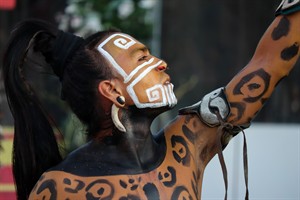PIRMĀ SEMESTRA NOSLĒGUMA TESTI
Tattoos and piercings are not just modern fashion – they have deep traditional meanings in many cultures around the world. In this activity, you will explore some of the key words from the reading. Your task is to read the text. Then find the correct word in the text that matches each definition. Write it down in the respective place.
You can also use the word bank. It is like a helper where you can find the necessary word.
Word bank: tattoo, piercing, family, moko, nose, large, ear, people, story, lips, body, skin, powerful, women, nature, marriage
More than decoration: the traditional meaning of tattoos and piercings

Today, many people get tattoos and piercings to look cool or show their personal style. But in the past, these body decorations were often more than just fashion – they were full of tradition, history, and meaning.
In Polynesian cultures, tattoos were a powerful symbol. Every line and shape had a purpose. A person’s tattoo could tell you their family history, social status, or achievements. Getting a tattoo was also a spiritual experience, often done with traditional tools made from bone or shell. It was a way to connect with ancestors and nature.
In Maori culture in New Zealand, both men and women wore tattoos called moko. These were not just designs – they were like a personal story written on the skin. A man’s moko might show his tribe, his bravery, or his role in society. For women, moko were often placed on the chin and lips, showing beauty, strength, and identity.
In India and Nepal, women have worn nose piercings for hundreds of years. In some regions, it’s a sign of marriage, while in others it’s believed to bring health benefits. Ear piercings are also common and are often part of religious or coming-of-age ceremonies. This is a type of ceremony which shows that a person is grown-up.
In some African tribes, large earrings, lip plates, or stretched earlobes are traditional. These aren’t seen as unusual – they are a sign of beauty, pride, and connection to the tribe. Children often begin wearing jewelry at a young age as part of their cultural identity.
In many cultures, these traditions are still alive today. While modern tattoos and piercings may look different, they still carry a message. They can show where you come from, what you believe in, or who you are.
1. The part of the body on the side of the head that is used for hearing and can also be decorated with jewelry. —
2. Adult females who, in some cultures, have special tattoo or piercing traditions that show beauty, strength, or life events like marriage. —
3. The soft parts around the opening of the mouth, used for speaking, eating, or showing emotion. —
Atsauce:
Picture "Mayan warrior" – Oleg Elkov / Shutterstock.com
Lai iesniegtu atbildi un redzētu rezultātus, Tev nepieciešams autorizēties. Lūdzu, ielogojies savā profilā vai reģistrējies portālā!